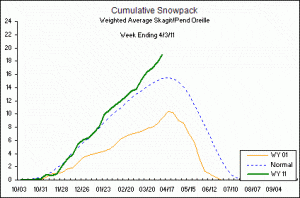 Seattle City Light Superintendent Jorge Carrasco expressed cautious optimism about power production this year. The utility entered April with near-record amounts of snowpack above its hydroelectric dams on the Pend Oreille and Skagit Rivers, promising a healthy supply of electricity this summer.
Seattle City Light Superintendent Jorge Carrasco expressed cautious optimism about power production this year. The utility entered April with near-record amounts of snowpack above its hydroelectric dams on the Pend Oreille and Skagit Rivers, promising a healthy supply of electricity this summer.
Seattle City Light Superintendent Jorge Carrasco expressed cautious optimism about power production this year. The utility entered April with near-record amounts of snowpack above its hydroelectric dams on the Pend Oreille and Skagit Rivers, promising a healthy supply of electricity this summer.
In the area of Pend Oreille River basin that feeds Boundary Dam in northeast Washington, the snowpack holds the equivalent of 31 inches of water. That’s a whopping 124 percent of the 30-year average. In the part of the Skagit River basin that feeds the Skagit Hydroelectric Project, the snowpack holds 42.5 inches of water, which is 19 percent above the 30-year average.
“The snowfall we have received in the mountains this winter was fantastic,” Carrasco said. “But having enough snow to make electricity is only one part of meeting our operating, financial and environmental needs.”
The challenge for City Light on the Skagit River, where the utility operates Ross, Diablo and Gorge dams, is to manage river flows to protect spawning steelhead, which were federally listed as a threatened species in 2007.
City Light is adjusting its operations in response to the large snowpack by increasing the amount of water it releases into the river for the next two months. This will make more room in Ross Lake to hold water and reduce river flows when the spring runoff picks up in May and June. Without these flow adjustments, higher flows in June or July could scour the redds where steelhead lay their eggs, wiping out thousands of young fish.
While winter snows have recharged the glaciers and snowfields that act as a “battery” for the dams, the robust supply of potential power does not guarantee a financial windfall for City Light. The continuing effects of the national recession, low natural gas prices, and abundant power supplies continue to push short-term wholesale electricity prices down. City Light sells a considerable amount of surplus power, which helps the utility maintain some of the lowest rates in the nation for its retail customers.
In March, the average daytime price for a megawatt-hour of electricity was $20.60. That’s the lowest it’s been since 1999 and about half of the $40.31 price from a year ago. Nighttime prices averaged $11.98 per megawatt-hour, a record low since recordkeeping started in 1998.
“We’re in good shape overall, but it isn’t a banner year by any stretch,” Financial Officer Phil Leiber said. “Our budget for 2011 anticipated $96.8 million of net wholesale revenue from surplus power sales. Our current forecast projects $92.3 million.”
“The outlook has improved in recent months,” Leiber said, noting that the utility does not anticipate the need for a Rate Stabilization Account surcharge in 2011 to make up for the expected drop in revenue.
Another caution about forecasts is the unpredictable nature of weather pattern changes during the year.
For example, in 2001, Seattle City Light entered April with an average snowpack in the mountains, and then encountered a four-month drought that set record lows for precipitation, reducing the utility’s ability to make electricity in the late summer and early fall.
“It can turn around very quickly,” said Power Marketer Don Tinker, who monitors water conditions for City Light.
Seattle City Light is the 10th largest public electric utility in the United States. It has some of the lowest cost customer rates of any urban utility, providing reliable, renewable and environmentally responsible power to nearly 1 million Seattle area residents. City Light has been greenhouse gas neutral since 2005, the first electric utility in the nation to achieve that distinction.
